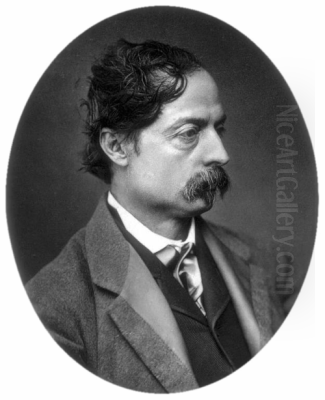
Sir William Quiller Orchardson RA was a distinguished Scottish painter, celebrated for his poignant depictions of domestic drama, historical scenes, and insightful portraiture. Flourishing in the latter half of the 19th century and into the early 20th century, Orchardson carved a unique niche for himself within the vibrant and often eclectic British art scene. His work is characterized by subtle psychological tension, elegant compositions often featuring large, sparsely furnished spaces, and a distinctive, somewhat muted colour palette that earned him the moniker of a "harmonist in yellow and grey." He was a master storyteller on canvas, inviting viewers to decipher the unspoken narratives within his carefully constructed scenes.
Early Life and Artistic Formation in Edinburgh
William Quiller Orchardson was born on March 27, 1832, in Edinburgh, Scotland. His father was a tailor, and the family, while not affluent, supported his early artistic inclinations. At the young age of thirteen, in 1845 (though some sources state 1850 as his formal enrollment in advanced studies), he began his artistic training at the renowned Trustees' Academy in Edinburgh. This institution was a crucible for many talented Scottish artists of the period.
During his time at the Trustees' Academy, which extended until around 1857, Orchardson studied under the influential painter Robert Scott Lauder. Lauder was a gifted teacher who encouraged his students to develop their individual styles while grounding them in strong academic principles. Orchardson was part of a talented cohort of students under Lauder, many of whom would go on to achieve significant recognition. This group included John Pettie, who would become a lifelong friend and collaborator, as well as William McTaggart, Peter Graham, Hugh Cameron, and George Heaton. These young artists often formed sketching clubs, fostering a spirit of camaraderie and mutual learning. One such club, which Orchardson was part of, reportedly engaged with the ideals of the Pre-Raphaelite Brotherhood around 1857, exploring their emphasis on truth to nature and detailed rendering, though Orchardson's mature style would diverge significantly from theirs.
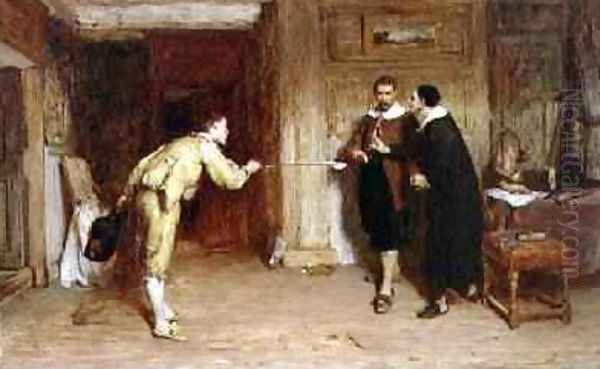
After completing his studies, Orchardson remained in Edinburgh for approximately fifteen years, honing his craft and beginning to establish his reputation. He initially focused on portraits and illustrations, gradually expanding his repertoire to include literary and historical subjects. His early work already showed a penchant for careful draughtsmanship and an interest in narrative.
The Move to London and Establishing a Reputation
In 1862, seeking greater opportunities and exposure, Orchardson made the pivotal decision to move to London, the bustling heart of the British art world. He initially shared a studio with his friend John Pettie at 37 Fitzroy Square, and later they moved to 6 Stratford Place. The London art scene was highly competitive, dominated by the Royal Academy of Arts and populated by established figures like Frederic Leighton, John Everett Millais (who had by then moved beyond his strict Pre-Raphaelite phase), and Lawrence Alma-Tadema.
Orchardson's early years in London were met with mixed success. His distinctive style, often characterized by its subtle colour harmonies and emphasis on psychological nuance rather than overt melodrama, took time to gain appreciation. He began exhibiting at the Royal Academy, and one of his early notable works shown there was The Challenge (1865), a historical scene depicting a medieval duel. Another work from this period, The Story of a Life (1866), exhibited at the Royal Academy, garnered some critical attention. While praised for its emotional depth, it also faced criticism, with some reviewers, like those from The Art Journal, finding fault with its perceived lack of vibrant colour and what they described as a "rough" or "slovenly" handling of paint. This highlights the initial resistance his unique palette and technique sometimes encountered.
Despite these early challenges, Orchardson persevered, gradually refining his style and thematic concerns. He was elected an Associate of the Royal Academy (ARA) in 1868, a significant recognition of his growing stature. This was followed by his election as a full Royal Academician (RA) in 1877, cementing his position within the British art establishment.
The Orchardson Style: Technique, Themes, and Psychological Depth
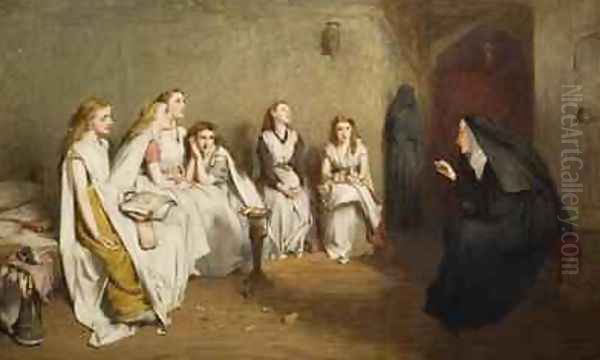
Orchardson's artistic style is highly distinctive. He became known for what some contemporaries termed a "black and white style," which referred less to a literal absence of colour and more to his sophisticated use of a limited, harmonious palette, often dominated by ochres, creams, pale yellows, greys, and subtle browns. This allowed him to focus on tonal values, light, and shadow to create mood and define form. His brushwork, while seemingly loose in places, was incredibly deliberate, contributing to the overall texture and atmosphere of his paintings.
A hallmark of Orchardson's compositions is his masterful use of space. He frequently depicted figures in large, sparsely decorated interiors, creating a sense of isolation or emphasizing the psychological distance between characters. This strategic use of "empty" space became a powerful narrative tool, amplifying the emotional undercurrents of his scenes. His figures are often elegant and refined, their gestures and expressions subtle yet highly communicative.
His subject matter was diverse, encompassing historical scenes, literary adaptations (particularly from Shakespeare, such as Christopher Sly or Queen of the Swords), and, most famously, scenes of contemporary upper-class domestic life. These domestic dramas, often hinting at marital discord or social anxieties, resonated deeply with Victorian audiences. He was less interested in grand historical events and more in the personal, human dramas that unfolded within historical or contemporary settings. His approach was influenced by a romantic sensibility, focusing on individual emotion and experience, coupled with a keen observation of social mores. There's also an argument to be made for his awareness of French artistic trends, including the precision of academic painters like Jean-Léon Gérôme or Ernest Meissonier in historical detail, and perhaps a subtle nod to the atmospheric qualities explored by painters like James McNeill Whistler, though Orchardson's narrative focus remained paramount.
Masterpieces of Narrative and Emotion
Several of Orchardson's paintings stand out as iconic examples of his mature style and thematic concerns.
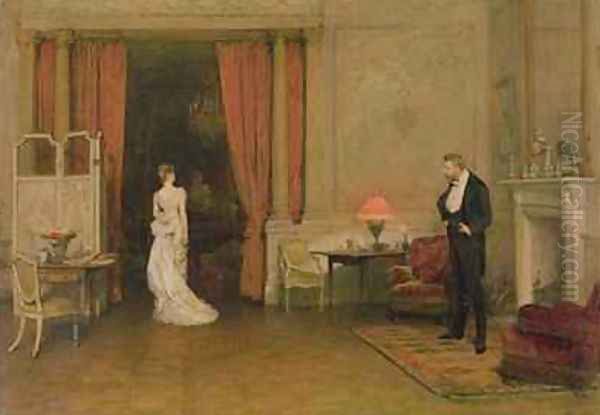
Napoleon on Board H.M.S. Bellerophon (1880) is arguably his most famous work. Exhibited at the Royal Academy in 1880, it depicts the defeated French emperor aboard the British warship that would transport him to his final exile. Orchardson chose not to portray a moment of high drama or military grandeur, but rather a quiet, introspective scene. Napoleon stands alone at the stern, gazing out to sea, his back to a group of his officers and British sailors who observe him with a mixture of curiosity and respect. The vast expanse of sea and sky emphasizes his isolation and the gravity of his fate. The painting was a critical and popular success, lauded for its historical accuracy, psychological insight, and masterful composition. It was purchased for the nation under the terms of the Chantrey Bequest and now resides in the Tate collection. This work was so impactful it was even referred to as winning the "Oscar" of British art at the time. Orchardson's portrayal of Napoleon was distinctive; he often focused on the more intimate, thoughtful, or vulnerable aspects of the emperor, rather than the heroic military figure typically seen in art of the First Empire.
The Mariage de Convenance series is another of Orchardson's triumphs. The first painting, Mariage de Convenance (1883), shows a young wife and her much older, wealthy husband at opposite ends of a long dining table in a lavishly appointed room. The physical distance between them mirrors their emotional estrangement. The young wife looks despondent, while the husband seems oblivious or resigned. The painting is a poignant commentary on arranged marriages and the societal pressures faced by women.
This was followed by Mariage de Convenance – After! (1886), which depicts the same room, now empty except for the elderly husband, who sits alone, a letter presumably from his departed wife in his hand. The sense of loss and regret is palpable. This pair of paintings showcases Orchardson's skill in sequential narrative and his ability to convey complex emotional states through subtle visual cues.
The First Cloud (1887) is another powerful domestic drama. It depicts a young, elegantly dressed couple in a moment of conflict. The wife, her back to the viewer, is about to leave the room, while the husband stands by the fireplace, his expression a mixture of anger and concern. The title suggests the beginning of marital troubles, and the opulent setting contrasts sharply with the emotional turmoil.
Her Mother's Voice (1888) offers a more tender scene. A father listens as his daughter sings at the piano, her voice presumably reminding him of his late wife. The painting is imbued with a gentle melancholy and explores themes of memory, loss, and familial love. Orchardson's ability to capture such nuanced emotions was a key element of his appeal.
Other significant works include Hard Hit (or A Hard Hit), depicting a card game gone wrong, and Conditional Neutrality, both of which demonstrate his skill in portraying social interactions and their underlying tensions. His works were praised for their "refined dignity" and meticulous attention to historical detail when appropriate.
Portraiture and Later Career
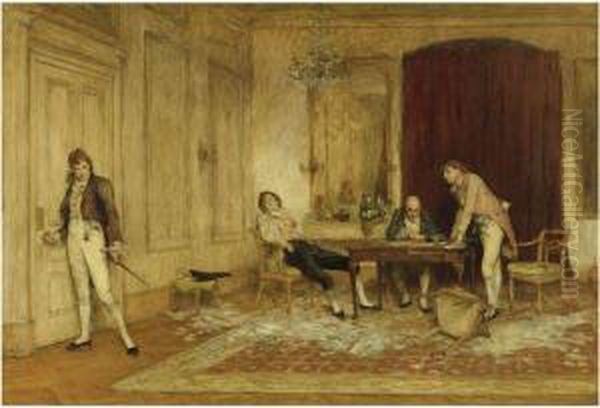
Beyond his narrative paintings, Orchardson was also an accomplished portraitist. He painted many prominent figures of his day, bringing the same psychological acuity and refined technique to his portraits as he did to his subject pictures. His portraits are characterized by their elegance, understated colour schemes, and ability to capture the sitter's personality. Notable examples include portraits of Sir Walter Gilbey, Lord Kelvin, and Orchardson's own self-portraits.
Throughout his career, Orchardson remained a dedicated and meticulous craftsman. He was known for his careful preparatory work, including numerous sketches and studies. His commitment to his unique artistic vision, even when it initially ran counter to prevailing tastes, eventually earned him widespread respect and admiration.
In 1907, his contributions to British art were formally recognized when he was knighted, becoming Sir William Quiller Orchardson. This honor capped a long and distinguished career.
Connections with Contemporaries and Artistic Milieu
Orchardson's career spanned a dynamic period in British art. While he maintained a distinct personal style, he was well-connected within the artistic community. His early associations in Edinburgh with Robert Scott Lauder and fellow students like John Pettie, William McTaggart, Peter Graham, Hugh Cameron, and George Heaton were formative. The sketching club they formed, and their brief engagement with Pre-Raphaelite ideas (though artists like John Everett Millais, Dante Gabriel Rossetti, and William Holman Hunt were the movement's pioneers), provided a stimulating environment.
In London, his close friendship and studio-sharing arrangement with John Pettie continued. Both artists achieved success, though their styles differed, with Pettie often favoring more robustly painted historical and romantic subjects. Orchardson exhibited alongside the titans of Victorian academic art at the Royal Academy, such as Frederic Leighton, Lawrence Alma-Tadema, and Edward Poynter. While their opulent classicism or detailed historical reconstructions differed from Orchardson's more psychologically focused and spatially minimalist approach, they were all part of the same institutional framework.
His work can also be seen in contrast to the burgeoning Aesthetic Movement, championed by artists like James McNeill Whistler and Albert Moore, who prioritized "art for art's sake" and formal qualities over narrative content. Orchardson, while highly attuned to aesthetic harmony, remained deeply committed to storytelling and the depiction of human emotion. His unique position allowed him to be respected by various factions, even if he didn't strictly belong to any single school or movement after his early Edinburgh days.
Legacy and Enduring Appeal
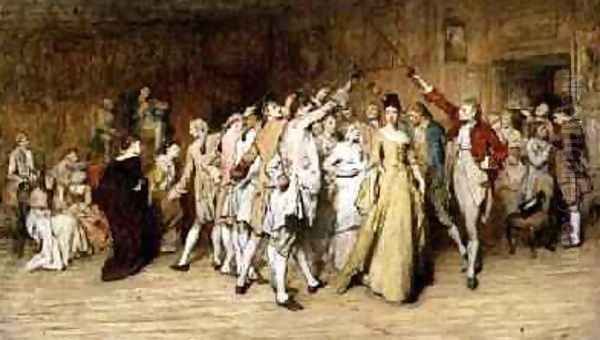
Sir William Quiller Orchardson passed away on April 13, 1910, in London, leaving behind a significant body of work that continues to fascinate and engage viewers. His paintings are held in major collections in the United Kingdom and internationally.
His legacy lies in his mastery of psychological narrative, his innovative use of composition and space, and his distinctive colour sense. He brought a new level of subtlety and introspection to Victorian subject painting, particularly in his depictions of domestic life. While some of his contemporaries focused on grand spectacle or moralistic tales, Orchardson excelled at capturing the quiet, often unspoken dramas of human relationships.
His influence can be seen in later artists who explored similar themes of social observation and psychological tension. The enduring appeal of his work lies in its timeless exploration of human emotions – love, loss, conflict, and solitude – presented with an elegance and technical finesse that mark him as one of the most original and accomplished painters of his era. His ability to make the viewer an active participant in deciphering the narrative, to read between the lines of his carefully staged scenes, ensures his continued relevance in the history of art.